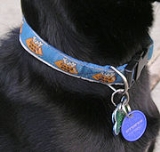
Dog tag
Encyclopedia

Dog collar
A dog collar is a is a piece of material put around the neck of a dog. A collar might be used for control, identification, fashion, or other purposes. Identification tags and medical information is often placed on dog collars. Collars are also useful for controlling a dog manually, as they provide...
s or harnesses
Dog harness
A dog harness is piece of equipment for dogs, generally similar to harness tack for horses. There are various designs depending on the type of use, whether it be for assistance to a disabled person, hauling a cart or sled, or pulling a human being, such as in skijoring or pulka...
.
Humane societies and rescue organizations recommend that dogs and cats wear these tags, which contain information to enable someone encountering a stray animal to contact the owner.
Some people object to pet id tags because of the jingling noise they make as their animals move. A collar-mount tag, either slide-on or riveted-on, flat to a collar's surface, is silent and therefore avoids this problem. Other people use a tag silencer to enclose the loose tags in a small neoprene pouch or a soft rubbery plastic ring around the edge of a tag.
The resemblance of human identification tags to this method of display led to military identification tags being called dog tags.
Identifying information
Identifying information on dog tags might include:- On a license tag, the dog license number and contact information for the licensing organization
- On a pet ID tag, the pet's name, owner's phone number(s), address, or both, a reward offer, and a list of the animal's critical medical problems
- On a microchipMicrochip implant (animal)A microchip implant is an identifying integrated circuit placed under the skin of a dog, cat, horse, parrot or other animal. The chips are about the size of a large grain of rice and are based on a passive RFID technology....
registry tag, an identifying number for the dog with a phone number for the registry.
Some organizations recommend not putting a pet's name on an ID tag because, in an ownership dispute over a stray dog, the original owner could use the pet's name to demonstrate that the pet recognizes the name and therefore has an association with that owner. Others believe that a lost pet might feel more comfortable if strangers call it by its own name, so the name should be on the tag. Also, if a stray dog slips out of his collar, or is skittish, there is a greater chance of controlling him if his name is used.
Materials
Tags are made of a variety of materials.Metal tags usually have their information emboss
EMBOSS
EMBOSS is an acronym for European Molecular Biology Open Software Suite. EMBOSS is a free Open Source software analysis package specially developed for the needs of the molecular biology and bioinformatics user community...
ed or engraved onto, or stamped into, their surface(s). The characters created by embossing or engraving are made by removing some of the tag's surface and are not typically as deep as stamped characters, which are made by stamping the tag with a metal die. Stamped tags are therefore often more durable than engraved tags, though some drag-engraving and laser engraving
Laser engraving
Laser engraving, or laser marking, is the practice of using lasers to engrave or mark an object. The technique does not involve the use of inks, nor does it involve tool bits which contact the engraving surface and wear out...
methods can be as deep, or deeper, than the stamped versions.
Plastic chips can be etched or printed, come in many colors, and are often highly reflective to make the dog more visible if it gets loose and runs into the street after dark. Some plastics are sensitive to ultraviolet light and the color and even composition can fade over time. ABS plastics are among the most durable for use as pet i.d. tags.
The newest technology is now using sublimation to print images and artwork to aluminum tags. The image is permanent and resists fading and wear. 3D printing
3D printing
3D printing is a form of additive manufacturing technology where a three dimensional object is created by laying down successive layers of material. 3D printers are generally faster, more affordable, and easier to use than other additive manufacturing technologies. However, the term 3D printing is...
is also now being used to create really unique tags from all materials.
The most common metals used for pet tags of are aluminum, stainless steel, and brass. Aluminum is by far the least durable of the three. Brass is a soft metal, and not as durable as stainless steel. There are varying grades of stainless steel used for tags, but all variants are by far harder and more durably retain their lettering after wear and tear on a pet.
Effectiveness
In this age of mobile phones, pet ID tags showing a pet's owner's cell phone and/or landline numbers make it easy for someone finding a stray pet to contact the owner.Microchip implants
Microchip implant (animal)
A microchip implant is an identifying integrated circuit placed under the skin of a dog, cat, horse, parrot or other animal. The chips are about the size of a large grain of rice and are based on a passive RFID technology....
, tattoo
Tattoo
A tattoo is made by inserting indelible ink into the dermis layer of the skin to change the pigment. Tattoos on humans are a type of body modification, and tattoos on other animals are most commonly used for identification purposes...
ing, and registering the dog's license number, microchip information, and tattoo number with lost-pet registries are good backups to identify stolen pets or strays found without ID tags.

